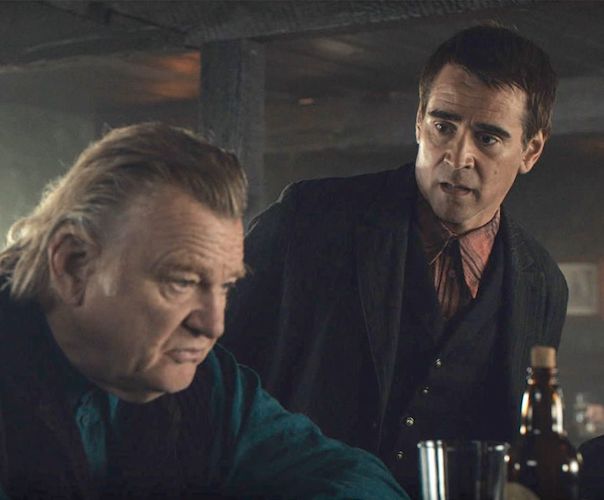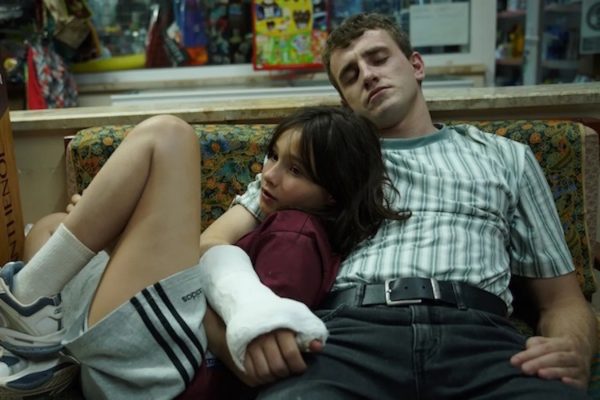Film Review: Female Trouble and Male Troublemaking in “The Banshees of Inisherin” and “Aftersun”
By Peter Keough
Both of these films explore the theme of difficult males and resilient, caregiving females.
The Banshees of Inisherin at the Kendall Square and Boston Common Cinemas. Aftersun at Boston Common Cinemas, opening at Coolidge Corner Theatre on November 4.

Brendan Gleeson and Colin Farrell in a scene from The Banshees of Inisherin.
Though Martin McDonagh’s raunchy, rollicking revue of dark Irish stereotypes The Banshees of Inisherin and Charlotte Wells’s exquisite and elliptical palimpsest Aftersun don’t seem to have much in common (dense Celtic accents, childhood trauma, water imagery, excellent soundtracks, damaged extremities), they both explore the theme of troubled males and resilient, caregiving females.
In McDonagh’s film, Pádraic (Colin Farrell, genial and slow-witted with eyebrows that threaten to run off with his face), a native of the title fictitious Irish island (the film is shot on Inishmore and Achill Island on the west coast of Ireland) would seem at first to be pursuing a safe and dull life, free of skidding into too much macho folly. But that dullness turns out to undo his friendship with Colm (Brendan Gleeson ), his oldest and best friend. Knocking on Colm’s cottage door one afternoon to invite him to join him at the pub as has been their daily ritual, Pádraic is surprised when his friend ignores him.
He is more dismayed when Colm shows up at the pub and won’t sit next to him. Has Pádraic done or said something offensive to him, perhaps when drunk, and forgotten about it? No it’s not that, Colm tells him, but he won’t explain why he is spurning him. Soon their falling out is one of the biggest controversies on the island — which says a lot, since it is 1923 and gunfire from the ongoing Irish Civil War can be heard from the mainland across the water. Finally, tired of Pádraic’s ceaseless badgering about the “row,” Colm tells him he doesn’t want anything to do with him because he’s boring.
Not one to take a hint, Pádraic persists. Colm, a violinist who composes and collects folk songs, tries to explain that at his age he can’t waste any more time listening to Pádraic tell stories about the strange things his miniature donkey ate (the animals in the cast tend to outshine the humans) or similar nonsense. He has music to write, deep thoughts to think. He can’t afford to be nice. Do you remember anyone nice from the 17th century? he asks. Was Mozart nice?
Mozart, as Pádraic’s sister Siobhán (Kerry Condon in one of the outstanding supporting performances of the year) gently points out to Colm, lived in the 18th, not the 17th century. It is a familiar role for her, correcting men, usually her brother, when they are wrong, pigheaded, self-destructive, or foolish, while at the same time reassuring them that they are none of those things. But she can mollify neither man. And as their irrationality escalates so do McDonagh’s narrative extravagances, and he falls back on the gruesome, sometimes gratuitous, and contrived devices that are his trademark.,
Colm tells Pádraic that he will cut off a finger each time he accosts him, an odd ultimatum if he is serious about playing the violin. When sSpoiler warning] a beloved animal chokes after eating severed digits, Pádraic vows to burn Colm’s house down. It makes metaphorical sense, perhaps, and their squabble, like that of the “weasels fighting in a hole” of Yeats’s poem “1919” might serve as a microcosm for the sordid, internecine warfare on the mainland — the origin of the Troubles that would plague Ireland for decades to come.
But Gleeson and Farrell fall short of the acrid chemistry of their performances in McDonagh’s In Bruges (2008). Their characters are in a similar situation – adrift and idle in an isolated, picturesque locale. But there is no urgency in their circumstances, not even a Godot to wait for. They are hyperbolic Hibernians blathering away in dialogue that might have made David Mamet wish he had kissed the Blarney Stone. Unfortunately, McDonagh cranks up the contrived and implausible grotesquerie. Condon’s Siobhán, with her depth, nobility, and common sense, tries her best, but men have to do what men have to do.

Frankie Corio and Paul Mescal in a scene from Aftersun. Photo: A24
In Charlotte Wells’s Aftersun the man, Calum (a superbly melancholy Paul Mescal), has to tend to Sophie (a luminous Frankie Corio), his 11-year-old daughter, during a vacation at a tacky seaside resort. But the roles are gradually reversed.
Offhand details identify the location as Turkey, and the camcorders, the arcade games, and the music (remember the “Macarena?”) establish the period as the ’90s. Intermittently the chronology flashes forward to the now adult Sophie (filmmaker Celia Rowlson-Hall) as she sorts through the old videos of the holiday, and a possibly imagined sequence punctuates the film in which she confronts her father, found dancing wildly at a strobe-lit rave to David Bowie and Queen’s “Under Pressure.” The scene, reminiscent of the end of Claire Denis’s Beau Travail (1999) is haunting, potent, and inexplicable.
Mysteries lurk at the edges of the obliquely observed, tenderly banal events. Calum’s forearm is in a cast, and he says he broke his wrist when he fell, but no details are given. Was it a fight, an accident, something aggressive or self-destructive? Sophie talks on the phone to her mother and Calum says to give her his love. Sophie asks him why he would say that since it seems he and his wife are estranged. And why is he so sad despite his efforts to be good company? Danger haunts the time and space beyond the frame, and though Calum struggles to subdue his demons, whatever they may be, through Tai Chi and touristy diversions, he finally gets drunk, walks out into the night, and leaves Sophie stranded and alone without a key to their hotel room.
Meanwhile, Wells fills the screen with mirrors, with mirrors within mirrors, with camcorder images and TV screens of mirrors within mirrors with the images of Calum and Sophie duplicated but not quite coming together. The two have the odd habit of anointing each other’s faces, and Calum ritualistically applies suntan lotion on his daughter each time they go to the pool, but closeness seems beyond reach. Underwater scenes alternate with shots of the sky filled with paragliders like floating milkweed seeds. As in McDonagh’s film, Wells falls back on metaphors pointing to elusive truths about time, memory, and male pathology.
Peter Keough writes about film and other topics and has contributed to numerous publications. He had been the film editor of the Boston Phoenix from 1989 to its demise in 2013 and has edited three books on film, most recently For Kids of All Ages: The National Society of Film Critics on Children’s Movies (Rowman & Littlefield, 2019).

These are the two films I’m counting on to end my malaise at the cinema with feature dramatic films, each worse than the next for all of 2022. So glad that the discerning Peter Keough likes them both and makes good cases for their worth.
Great reviews!
The Civil War going on in the background of Banshees isn’t really related to The Troubles.
Not at all? If not directly then the legacy of violence and the entrenchment of the IRA in the North would seem related. That seems McDonagh’s point anyway.